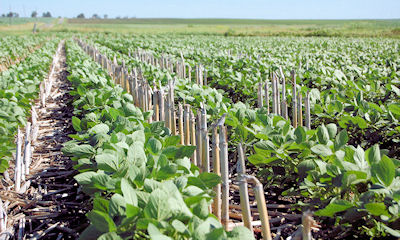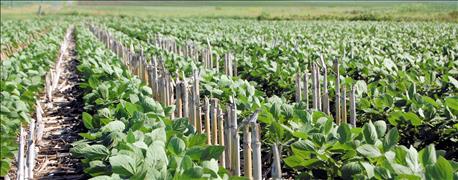
With lower grain prices expected through 2015, farmers must budget carefully and cut crop expenses that won’t harm yield. The idea is to get the most production for every unit of input.
That’s not an easy task, but there are management tips that can help. The largest expenses for corn production, for instance, are seed and fertilizer. For soybeans, it is seed. For wheat, it is fertilizer. Here are a few places you might consider monitoring.

No-till cropping systems conserve water and reduce fuel costs by reducing the number of passes across the field.
1. Give nitrogen credit where credit is due. There are a number of ways nitrogen can be managed in your fertility program without giving up yield. Consider testing manure you will be applying to your fields for nutrients. Be sure to consider soil nitrate credits, soil organic matter credits for nitrogen, and use of legume credits if you are planting corn or sorghum. “Research has shown that corn yields more following a legume, with less added nitrogen applications,” says University of Nebraska Extension soil scientist Charles Shapiro. The credit for alfalfa is up to 150 pounds of N per acre. UNL credits soybeans for about 45 pounds of N per acre. “Manure contains other nutrients besides nitrogen and the amount of these nutrients cannot be estimated without an analysis,” Shapiro says. “The value of manure varies, depending on the species, storage, handling and post application management.”
2. Manage and monitor irrigation equipment. Irrigation costs are not a small ticket item, so inefficient watering can hurt yield uniformity and increase expenses. “Irrigation costs can be as large as seed costs for some growers,” says Nebraska Extension educator Robert Tigner. “Managing the irrigation system correctly will reduce crop cost of production. And it might lead to improved yields due to better water application.” Watch for leaking nozzles and keep the pressure correct on center pivots for uniform watering. Schedule irrigation according to soil moisture sensors, so you don’t overwater and cause erosion problems.
3. Residue conserves moisture. Increasing crop residue conserves soil moisture and reduces evaporation during the growing season. “Residue management for this year’s crop can mean the difference between recapturing a grower’s out-of-pocket costs,” Tigner says. “We are pretty dry going into this growing season, and soil moisture must be conserved where possible.” No-till cropping systems conserve water and reduce fuel costs by reducing the number of passes across the field, but no-till also requires additional management and a new cropping philosophy. Do your research.
4. Set realistic crop yield expectations. Don’t reduce yield goals below productivity levels, but don’t overdo it by planning for an overdose of inputs striving to reach an unattainable yield goal. “The suggested way to determine yield expectation is to use the five-year average and add 5% to that number,” Shapiro says. If there was a particularly bad year, that could be thrown out. “The range of yields is less with irrigated production compared to rainfed,” he says. “One could actually use a slightly higher added percentage on rainfed, since the probability of a response above the average is greater,” because the variance is larger than with irrigated ground.
- Arens writes for our sister publication Nebraska Farmer
About the Author(s)
You May Also Like




